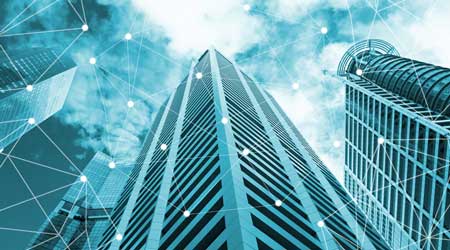Smart Buildings: Digital Strategy Leads to Frictionless Experience
Removing touchpoints and leveraging machine learning can smooth the transition back into the workplace.
As people begin to return to facilities of all kinds, the frictionless experience propels occupants to give up the comforts of working and playing at home to embracing the new built environment. It is critical for building owners and facility leaders to understand both sides of the frictionless experience, organizational performance, and the occupant when creating a digital strategy for the built environment. The commitment to a frictionless, personalized experience teaches us all a vital lesson about occupants — safe, engaging occupant experiences will drive utilization and loyalty.
Frictionless reality
How does the industry define a frictionless experience? Frictionless means that something can be “achieved with or involving little difficulty” or considered effortless. It also equates to minimal touching of surfaces in today's world, which now requires several disinfection acts. The simple motion of holding on to a stair railing or sharing a pen outside of the home heightens “surface phobia.”
The frictionless experience was coming along well before COVID-19. Disney and Amazon understand what it takes to engage occupants. They didn’t get there one technology or interaction at a time. These organizations took the time to create a vision of the frictionless occupant experience before developing an implementation plan.
Let’s take a look at the day and life of a potential frictionless office worker.
HOME
Sarah wakes up feeling refreshed and ready for the day. Her virtual assistant (VA) has summarized her morning wellness report, including REM sleep, heart health, and temperature. "All systems go" for in-office work. As Sarah gets ready for the commute, the VA updates her schedule and recommendations. The VA informs Sarah that Richard and Karen will call into the team meeting since they work from home. The intelligent building management system (iBMS) assigns Sarah to the smaller conference room on the tenth floor by the coffee lounge. The VA recommends that Sarah take her vehicle to work since traffic will be light, and there will be plenty of electric vehicle (EV) charging spots available based on employees’ travel and work from home schedules.
COMMUTE
Full autonomous driving makes the commute go by quickly. As Sarah approaches the office, the car drops her off at the entrance and proceeds to the iBMS provided EV parking coordinates. As Sarah enters the building, the door opens automatically, and the turnstile gives the green light to proceed. Walking towards the elevator lobby, Sarah sees her name on the digital display. It lets her know that elevator one is ready to take her to the tenth floor, where the team meeting is starting in 20 minutes. Elevator one opens the door as Sarah approaches. Once inside, Sarah notices that the tenth floor is already selected as well as the 15th floor. As soon as Bob enters, Sarah realizes he will be sharing the ride on his way to accounting.
WORK
When exiting the elevator, the building smartphone app alerts Sarah that the conference room will not be available for another 15 minutes while being disinfected from earlier meetings. With the extra 15 minutes, Sarah proceeds to the lounge to visit with others and grab a coffee. The coffee machine recognizes Sarah’s presence and asks, “Are you having the usual today?” Sarah verbally confirms her order, and the coffee is made just how she likes it. Close by, Sarah views an interactive display that can access information on the company’s performance, lunch menu, building health, and more. The company recently installed additional solar panels and energy storage to improve its sustainability efforts, so Sarah asks to see the current building statistics. The digital display shows a 10 percent overall improvement compared to last year and the amount of solar energy generated vs. energy consumed. After several minutes of "water cooler" talk, the building app alerts Sarah that the conference room is clean and ready. The digital display outside of the conference room shows "green" for the team meeting to proceed, and that one person is already in the room. As Sarah enters, the presentation and video conference connections are automatically being loaded and initiated.
The staff meeting goes well, and Sarah accesses the building app to request a place to work. There are several options, including private quiet rooms, communal areas, and outside tables. Based on the project Sarah is working on, she decides on a spot in the communal area. The app provides the best route to the work area showing a short three-minute walk. Just as Sarah approaches, the app sends an alert that the area has been closed for cleaning due to possible virus contamination from a person that recently visited the area. Sarah selects another available spot while hoping the app does not notify her that she encountered the infected person. The rest of the day goes smoothly, no need to quarantine. As the workday comes to an end, Sarah reflects on what the work environment was like in early 2020 and is grateful for the modern, safe, technology-advanced, frictionless environment she is experiencing now.
Related Topics:










